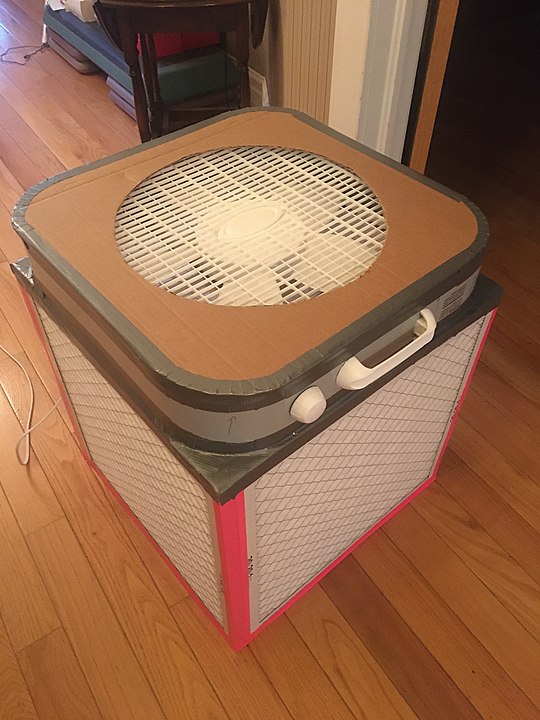
Since the World Health Organization declared COVID-19 a pandemic, evidence which includes voluminous amounts of peer-reviewed research, has accumulated that the virus causing COVID-19, is airborne. As we’ve learned over the past couple of years, indoor gatherings can be associated with “superspreading events.” Engineers have been working on methods to improve ventilation, with the intention of reducing indoor viral loads.
Air purifiers with HEPA filtration can be expensive, costing over $500. Richard Corsi, the incoming Dean of Engineering at the University of California, Davis spoke with “Wired” about an idea around combining multiple store-bought filters with a box fan to improve the efficiency of home-made air filter designs.
Rogers approached Jim Rosenthal, the CEO of filter manufacturer Tex-Air Filters, asking him to run some tests on a single air filter attached to a box fan. Rosenthal later developed a 5-filter design after being inspired by Corsi’s idea to use multiple filters.
Rosenthal named it after Corsi, but after a New York Times article mentioned the boxes by that name, Corsi tweeted that Rosenthal deserved the credit and that the name Corsi-Rosenthal Box was better.
In reality, neither Corsi nor Rosenthal invented the design, which was widely used by woodworkers to filter shop air of fine wood dust long before the pandemic.
The original Corsi-Rosenthal Box design was made up of five furnace filters with MERV13 or higher ratings that formed the sides and bottom of a cube. A 20-inch (500 mm) box fan is placed on top and duct taped to the filters, effectively sealing the system and drawing air through the filters, up and out of the box.
A more recent design, known as a Comparetto Cube, employs four filters and a cardboard base that can be placed directly on the floor. Rosenthal later improved the design by adding cardboard or similar material shrouds to the box fan’s corners to improve efficiency and reduce backflow.
The filtration units take about fifteen minutes to assemble, last for months, and cost between $50 and $150 in materials.
The size of virus particulates in the air ranges from 1 to 50 microns (m). Rosenthal ran an informal test of the design using his HVAC company’s testing equipment, and discovered that the system removed approximately 60% of 1 m particles and nearly 90% of 10 m particles.
In an August 2021 case study, UC Davis researchers estimated clean air delivery rates (CADR) of a $75 design to be between 165 and 239 (depending on fan speed). Corsi told GBH News in October 2021 that “People are now reporting clean air delivery rates of 600 cubic feet per minute (280 L/s). That’s incredible. This is actually superior to many of the more expensive HEPA-based portable air cleaners “.
A team from UC Davis published a study of a Corsi-Rosenthal box that used five 2-inch MERV-13 filters in April 2022. They discovered that the “effective clean air delivery rate [CADR] of this design increased[d] with fan speed, from about 600 to 850 ft3 min1 (1019 to 1444 m3 h1)”. Based on the cost of their design, this output amounted to $0.08 per CADR, which is roughly ten times less expensive than commercial air purifiers that operate quietly.
A study of a home-built air purifier to remove wildfire smoke, which used a box fan and filter mounted in a window, revealed that particulate matter between 1 and 10 m in size was reduced by approximately 75%. According to Wired, this study may be indicative of the efficacy of similar filters for filtering virus particles of similar size to the particles studied.
